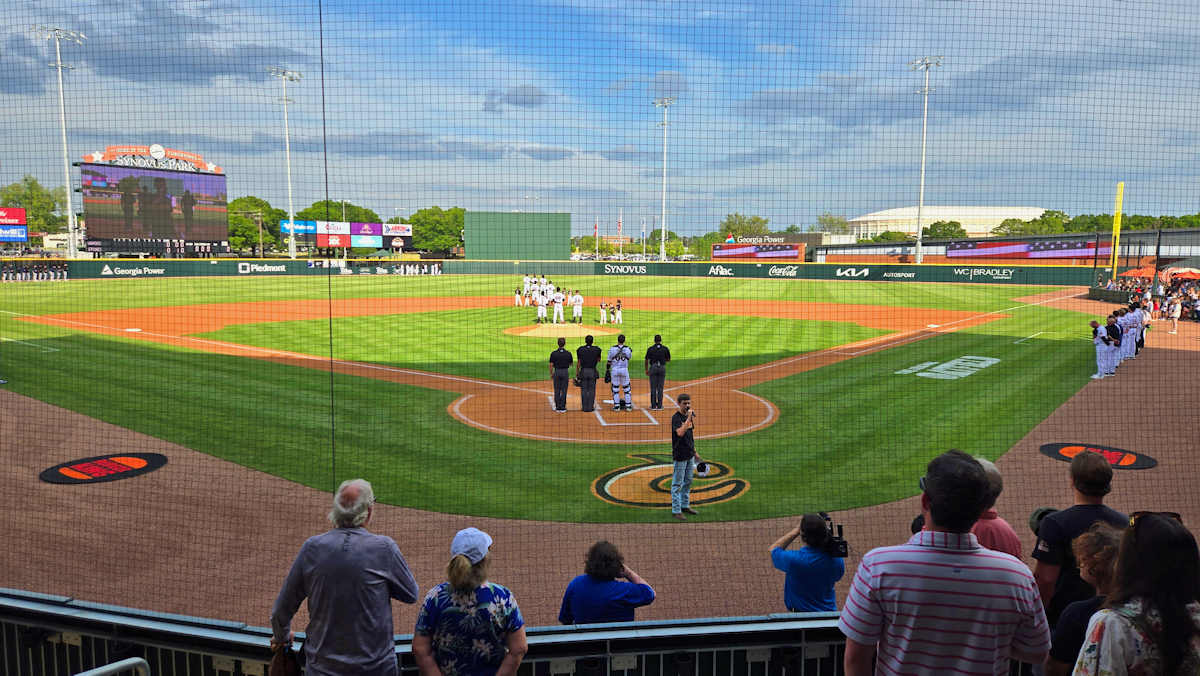
Article and photos by Joe Mock, BaseballParks.com. All rights reserved
COLUMBUS, Georgia In June of 2003, I visited Columbus to attend a game at Golden Park. The home team was the South Georgia Waves of the Low-A South Atlantic League.
| Ballpark Stats |
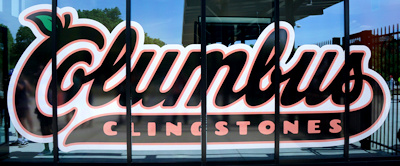 |
| Team: Columbus Clingstones of the Double-A Southern League |
| First game: April 15, 2025, a 3-0 win over Pensacola |
| Capacity: 5,500 |
| Dimensions: LF – 325′; LCF – 362′; CF – 400′; RCF – 352′; RF – 325′ |
| Fence height: 8′ |
| Design-Build Team: Brasfield & Gorrie (Wes Kelley division manager) and Populous (Geoff Kornegay lead designer, Jason Michael Ford principal in charge) |
| Project Manager: Canopy (Jackie Riggleman project lead) |
| Price: $50 million, funded by the City of Columbus |
| Home dugout: 1B side |
| Field points: due east |
| Playing surface: natural grass (Northbridge bermuda) |
| Corporate sponsor: Synovus Bank |
| Ticket info: Clingstones website |
| Betcha didn’t know: According to TheKitchn.com (yes, it’s really spelled that way), there are two categories of peaches: “Freestone peaches are easy to remove from the pit and are ideal for eating out of hand, while clingstones have a harder-to-remove pit but a slightly sweeter taste.” You already knew peaches are a major crop in Georgia. Now you know that the team’s clever, alliterative nickname is a type of peach. |
It had been a tumultuous few months for the franchise. The team had played the 2002 season 86 miles away in Albany, Georgia, which really is in South Georgia (Columbus not so much). The nickname of Waves made no sense in either city, as it was a carryover from the team’s stint in Wilmington, North Carolina that ended in 2001. Same thing with the big blue mascot named Crash.
The team intended to play the 2003 season back in Albany, but less than two weeks before opening day, an impasse erupted over the financials of using the city’s Eames Stadium. So owner David Heller abruptly moved the team to Columbus’ Golden Park, which was vacant after a franchise called the RedStixx moved away to Eastlake, Ohio the previous fall.
The plan was for the Waves to play there one year, then relocate to a to-be-built ballpark in Evansville, Indiana. Famous investors like Don Mattingly and Cal Ripken, Jr. were supposedly onboard. Those plans fell apart, the park in Evansville was never built, and the Waves franchise eventually ended up in Bowling Green, Kentucky.
When I visited in 2003, the lack of offseason preparations in the Columbus market was apparent, as crowds were miniscule — made all the worse because locals viewed the arrangement as a lame-duck season with the impending move to Indiana.
So scant promotions made for a definite lack of interest by Columbus residents. There were no radio broadcasts of games. Attendance for the entire season totaled only 30,565. The next smallest attendance in the Sally League that year was 92,321 at the small town of Kannapolis.
Naturally, there were only a handful of fans on hand when I visited. However, there was one quirky event that I still remember vividly to this day.
So around the third inning, I watched as a batter hit a double, and after rounding second base, he put on the brakes. He then noticed that the outfielder had misplayed the ball, so he shifted from reverse to forward and sped into third base. Seemed to me like an obvious error on the play, but the scoreboard only showed it as a hit, as no error was added to the fielding team’s total.
A couple of innings later, I wandered up to the ramshackle pressbox to say hello to whoever was working there. I encountered a dear lady named Kathy Gierer, who told me she’d been the official scorekeeper there since the 1970s. And not only was she the scorekeeper that day, she was also operating the scoreboard and doing the PA announcements!
We struck up a conversation. I mentioned that I never saw an error show up on the scoreboard when the batter stopped after coming around second, but then took off for third when he saw the centerfielder drop the ball.
“Oh, he stopped?”
“Yes, I was looking right at him.”
Without skipping a beat, she smacked a button on the device that controlled the scoreboard to add an error. In the middle of another player’s at bat. Two innings after the misplay.
| Golden Park |
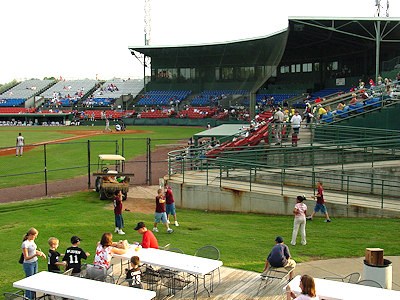 |
| The predecessor to Synovus Park was Golden Park, shown here in 2003. Note the assault on your eyes of the mismatched seat colors. |
If there would have been any kind of crowd there that day, there might have been a lot of puzzled looks by the fans. But that’s how things operated during what everyone thought was a lame-duck season.
By the way, when the team stayed put instead of moving to Indiana, they rebranded as the Columbus Catfish. They played two more seasons at Golden Park, finishing last in attendance in the Sally League both years. Then it was off to Bowling Green.
Now all these years later, affiliated Minor League Baseball is back in Columbus. And the market is even getting a promotion, as the franchise that left was Low-A while the new team is in the Double-A Southern League.
And on the day when all of this was announced in January 2024, the first person the local TV station ran to was Kathy Gierer. They interviewed her on the playing field of Golden Park to get her reaction.
“I think having Minor League Baseball back will be just wonderful for this community,” she told the local reporter.
And maybe the best news for locals is that the Atlanta Braves are the new team’s parent. You see, Columbus is squarely in Braves Country.
| The GM and the architect |
 |
| Two individuals who were significantly influential on the creation of Synovus Park are team GM Pete Laven and Populous’ Jason Michael Ford. |
Golden Park is now called Synovus Park, named after a local bank. Gone are the rundown pressbox and rusty seats, and in their place is $50 million of state-of-the-art improvements.
Also absent is the apathy the local community showed toward the Waves over two decades ago. Instead there are packed stands to root for the team now called the Columbus Clingstones. In fact, the opening homestand of six games April 15-20, 2025 drew 24,733 fans — not bad when you consider the total attendance for the entire 2003 season there barely topped 30,000!
Added Jackie Riggleman, team leader of project manager Canopy, “For me, what defines success in a project like this is when the community and the fans take pride in it and they want to come back.
“You could just feel the buzz and energy in the community. Seeing that happen was really, really special.”
“I used to come here when this was Golden Park,” Columbus resident Kirsti Hamilton told me during the opening homestand. “This is bringing culture to Columbus, and Columbus deserves it.
“Now my kids can experience what I did when I was growing up here.”
Let’s examine the rebuilt ballpark’s setting, its impact on the community, its architecture and its gameday experience … so keep reading!
The Setting
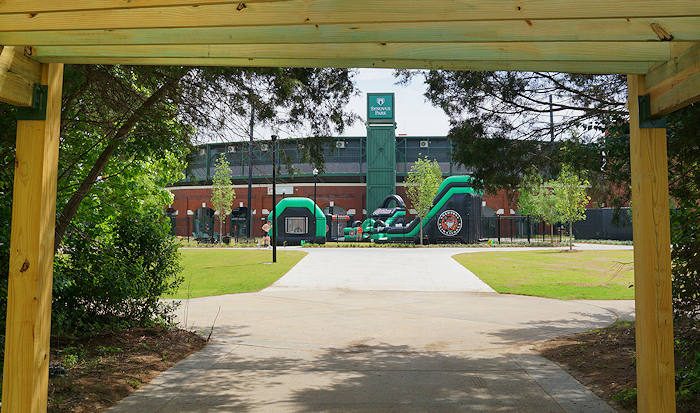
Well, way down yonder on the Chattahoochee
It gets hotter than a hoochie coochie
Alan Jackson’s three-times-platinum hit on Country radio in 1993 was indeed called Chattahoochee. One wonders if he was ever pressed to define exactly what a “hoochie coochie” is!
The city of Columbus indeed rests on the banks of the Chattahoochee River, with the state of Alabama sitting across the “muddy waters,” as Jackson referred to it.
| Fuzzy and Skip |
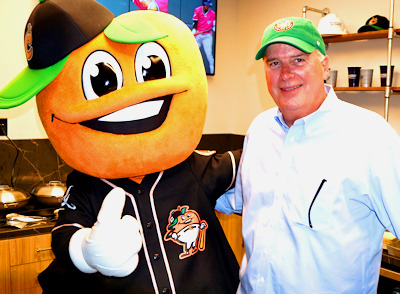 |
| B.H. “Skip” Henderson III, shown here with the Clingstones’ mascot Fuzzy, is in the middle of his second term as mayor, so he was involved in all of the discussions to bring baseball back to his city by rebuilding Golden Park. |
And the site of Synovus Park is virtually on the river’s banks, where baseball has been played since 1909. In 1926, stands were built around the playing field and it was first called Golden Park, named for local foundry owner Theo Golden. He is credited with bringing the first South Atlantic League team to the city during the Roaring Twenties.
After a parade of teams with nicknames like Foxes, Red Birds, Cardinals, Pirates, Confederate Yankees, Indians and RedStixx, the ballpark hosted the softball events in the 1996 Summer Olympics.
When affiliated Minor League baseball finally bid adieu to Columbus in 2008, locals doubted it would ever return. After all, its ballpark was 82 years old.
“I always believed this was a baseball town,” Mayor Skip Henderson told me during opening week. He said when he was contacted by the Mississippi Braves to see if there was interest in the franchise relocating to Columbus when their lease was up in Pearl, Mississippi, his response was enthusiastic.
It was clear to all concerned that the old Golden Park wasn’t up to today’s standards, though, especially since MLB had decreed strict, new minimums on facilities for the players. “It was a great old stadium with great bones, but it took someone like Populous to bring it back to life.”
Architectural firm Populous partnered with Brasfield & Gorrie, the local firm tapped by the city to oversee the design-build project to expand and modernize Golden Park. Yes, it’s the same Populous that has designed NFL stadiums and World Cup venues around the world.
“You don’t get many opportunities to work on something like this to keep such historic, original elements in a ballpark,” observed Jason Michael Ford, Populous’ principal in charge for this project. As we will see, they did an impressive job of merging new and old structures — and there was a lot of new building that needed to be done.
 One reason Mayor Henderson was so eager to jump on this was because the city had long wanted to develop some of the land currently used as parking lots between the ballpark and the Columbus Civic Center (the photo above was taken between the ballpark and Civic Center). Fixing up the park and bringing affiliated Minor League baseball back to town was exactly the catalyst needed to get this endeavor going. “We took a holistic approach to all of this. Baseball is our springboard to further development,” explained Henderson. “Without baseball, everything was going to be a longshot. A lot of things would’ve had to fall into place.” He paused to look out at the packed stands at Synovus Park. “And they did.”
One reason Mayor Henderson was so eager to jump on this was because the city had long wanted to develop some of the land currently used as parking lots between the ballpark and the Columbus Civic Center (the photo above was taken between the ballpark and Civic Center). Fixing up the park and bringing affiliated Minor League baseball back to town was exactly the catalyst needed to get this endeavor going. “We took a holistic approach to all of this. Baseball is our springboard to further development,” explained Henderson. “Without baseball, everything was going to be a longshot. A lot of things would’ve had to fall into place.” He paused to look out at the packed stands at Synovus Park. “And they did.”
The pricetag to do all of the work on the ballpark was $50 million. Unlike in larger metropolises where counties and states tend to usurp the role of the city that will actually manage the finished product, things were much more streamlined here. Approvals came faster and timelines were accelerated. And the city footed the costs. They figure that revenue from the stores, hotel, apartments and eateries of the upcoming development will help recover that outlay.
 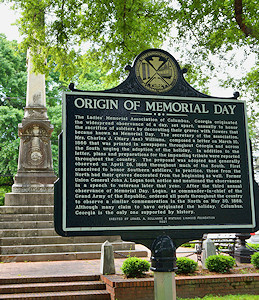 |
| The sign on the left welcomes you to this part of town. On the right is a monument erected in 1879 that honors fallen Confederate soldiers, and next to it is a historical marker explaining how Memorial Day was first celebrated in Columbus in 1866. |
Henderson’s city makes a nice destination for a weekend visit for a baseball fan. In particular, the Columbus Historic District is just to the north of the ballpark. Here the original brick streets of the appropriately named Broadway run along exceptional old homes, many formerly owned by prominent families from the 19th Century. One of those is a cottage owned by local druggist Dr. John Pemberton just before the Civil War. You might know him better as the inventor of the formula for Coca-Cola.
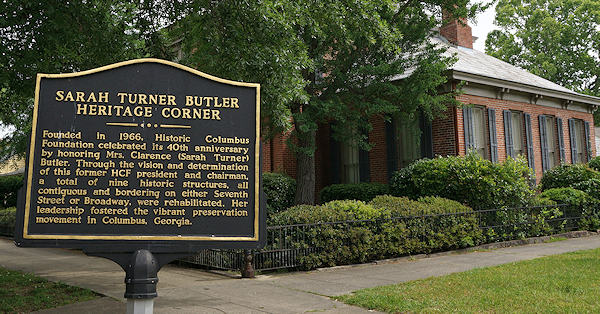
There are so many gorgeous homes with great backstories here that one block has a historical marker in front of every rehabilitated house.
And if you visit this area, you shouldn’t miss the Chattahoochee Riverwalk (below). It runs along the banks of the river for eight miles, including adjacent to the Historic District and Synovus Park (the photo at the top of this section shows a trellised walkway connecting the Riverwalk and the ballpark).
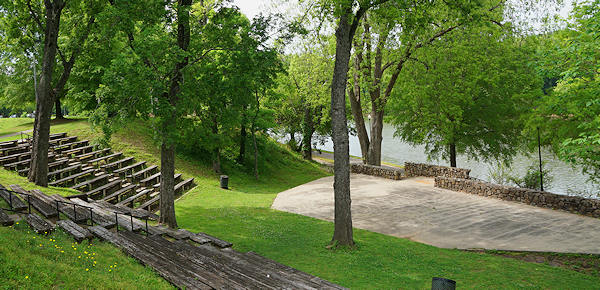
While this area of stately homes isn’t nearly as large as in Southern cities like Charleston and Savannah (nor are the houses the immense old mansions as in those two locales), the streets lined with huge magnolia trees and historical markers are something to be treasured in Columbus. Make sure you swing through on your way to the ballpark!
Page 2 describes the exterior look of Synovus Park, the architecture on the inside and what it’s like to attend a Clingstones game. Click below! And make sure to leave a comment at the end of this review.